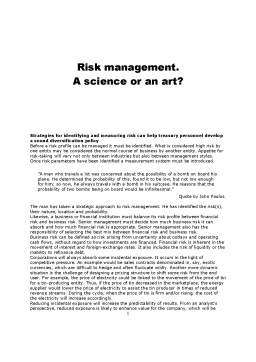Extras din referat
Strategies for identifying and measuring risk can help treasury personnel develop a sound diversification policy
Before a risk profile can be managed it must be identified. What is considered high risk by one entity may be considered the normal course of business by another entity. Appetite for risk-taking will vary not only between industries but also between management styles.
Once risk parameters have been identified a measurement system must be introduced.
"A man who travels a lot was concerned about the possibility of a bomb on board his plane. He determined the probability of this, found it to be low, but not low enough for him; so now, he always travels with a bomb in his suitcase. He reasons that the probability of two bombs being on board would be infinitesimal."
Quote by John Paulos.
The man has taken a strategic approach to risk management: He has identified the risk(s), their nature, location and probability.
Likewise, a business or financial institution must balance its risk profile between financial risk and business risk. Senior management must decide how much business risk it can absorb and how much financial risk is appropriate. Senior management also has the responsibility of selecting the best mix between financial risk and business risk.
Business risk can be defined as risk arising from uncertainty about outlays and operating cash flows, without regard to how investments are financed. Financial risk is inherent in the movement of interest and foreign-exchange rates. It also includes the risk of liquidity or the inability to refinance debt.
Corporations will always absorb some incidental exposure. It occurs in the light of competitive pressure. An example would be sales contracts denominated in, say, exotic currencies, which are difficult to hedge and often fluctuate wildly. Another more dynamic situation is the challenge of designing a pricing structure to shift some risk from the end user. For example, the price of electricity could be linked to the movement of the price of tin for a tin-producing entity. Thus, if the price of tin decreased in the marketplace, the energy supplier would lower the price of electricity to assist the tin producer in times of reduced revenue streams. During the cycle, when the price of tin is firm and/or rising, the cost of the electricity will increase accordingly.
Reducing incidental exposure will increase the predictability of results. From an analyst's perspective, reduced exposure is likely to enhance value for the company, which will be reflected in its share price. In the absence of a market view or a trend pattern developing, management should hedge against incidental exposure.
Mismanagement of incidental exposure can lead to an escalation of risk which eventually will impact on the core business exposure. Core business exposures are those that will directly impact on the business, are well known to the shareholders and often commented upon by analysts.
An airline company, for example would have the price of oil per barrel as core exposure. Management, investors and analysts alike would all be aware what impact an increase of US$2.00 per barrel would have on the cash flow projections of the airline company, should the company be unhedged.
A further illustration would be the impact of volatile interest rates on the cash flows of a highly geared/leveraged company. If the company did not have fixed rate funding, rising interest rates could have a devastating impact on its expense base.
Changing the core business exposures may lead to results difficult for investors to predict. This in turn may lead to investors liquidating their holdings or potential investors holding back. For the company to simply hedge these exposures may not be appropriate. Untimely hedging is likely to result in the creation of a competitive advantage to the competitor(s) and a loss of profit for the company.
With regard to core exposure on-going analysis and management is required to determine the optimal result.
Least Risk Strategy
The least risk strategy is unlikely to be a no risk strategy, except for the most basic of business units.
The least risk strategy for a fund manager may be to invest in the terms of the ratios dictated by a certain performance index. On the other hand, the least risk strategy of a pension fund unit of a large corporate entity may be to simply keep all monies in financial instruments not exceeding a tenor of ninety days. It often transpires that the least risk strategy of a corporate entity is in the parameters of the strategic plan which they chose to implement. However, in most instances the strategic plan that is implemented is indicative of the amount of risk the company is willing to absorb - both business and financial.
Whatever the least risk strategy is defined to be for a specific business unit or entity, it will allow for a useful benchmark. Management will only deviate from the least risk strategy if there is a change in the business environmental conditions, or through competitive pressures or a change in market view.
A change in the business strategy will inevitably create a change in the risk profile. To assist management to measure and compare risk profiles the alternative strategies can be compared to the least risk strategy. This will determine whether the potential gain will justify the risk to be taken and it will also identify which of the alternative strategies would be implemented.
Thus the success of decisions to deviate from the benchmark can be measured retrospectively.
Preview document
Conținut arhivă zip
- Risk Management - A Science Ar An Art.doc













